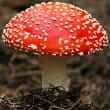Background
- Agaric, or Amanita muscaria, is a basidiomycete mushroom. Hallucinogenic effects occur upon consumption of the fungi. Fully grown, the cap is usually around 12cm in diameter (up to 30cm) with a distinctive blood-red color (crimson, fading to yellow with age), scattered with white to yellow, removable flecks (warts). It is often referred to as fly agaric due to European use as an insecticide, and its ability to stun or kill flies.
- Agaric has traditionally been used in rituals as a hallucinogen. Religious and ceremonial usage of agaric has been documented in Buddhist, Native American, Japanese, Siberian, ancient Greek, and proto-Hindi texts. Gathering and consuming mushrooms and other plants containing psychoactive substances have become increasingly popular among some people experimenting with drugs.
- Agaric is considered poisonous, though rarely fatal. Several studies document the toxicity and neurological effects of taking agaric by mouth. No formal trials regarding agaric toxicity or therapeutic benefit are currently available.
References
Natural Standard developed the above evidence-based information based on a thorough systematic review of the available scientific articles. For comprehensive information about alternative and complementary therapies on the professional level, go to . Selected references are listed below.
- Beavis AD. Properties of the inner membrane anion channel in intact mitochondria. J Bioenerg.Biomembr. 1992;24(1):77-90.
View Abstract - Benjamin DR. Mushroom poisoning in infants and children: the Amanita pantheria/muscaria group. Journal of Toxicology: Clinical Toxicology 1992;30(1):13-22.
- Falandysz J. [Selenium in selected species of mushrooms from Poland]. Rocz.Panstw.Zakl.Hig. 2003;54(3):249-254.
View Abstract - Falandysz J, Jedrusiak A, Lipka K, et al. Mercury in wild mushrooms and underlying soil substrate from Koszalin, North-central Poland. Chemosphere 2004;54(4):461-466.
View Abstract - Falandysz J, Lipka K, Gucia M, Kawano, et al. Accumulation factors of mercury in mushrooms from Zaborski Landscape Park, Poland. Environ.Int. 2002;28(5):421-427.
View Abstract - Garcia N, Zazueta C, Pavon N, et al. Agaric acid induces mitochondrial permeability transition through its interaction with the adenine nucleotide translocase. Its dependence on membrane fluidity. Mitochondrion. 2005;5(4):272-281.
View Abstract - Hajicek-Dobberstein S. Soma siddhas and alchemical enlightenment: psychedelic mushrooms in Buddhist tradition. J Ethnopharmacol. 1995;48(2):99-118.
View Abstract - Hood RL, Beitz DC, Johnson DC. Inhibition by potential metabolic inhibitors of in vitro adipose tissue lipogenesis. Comp Biochem.Physiol B 1985;81(3):667-670.
View Abstract - Lacaz CdaS, Heins-Vaccari EM., De Melo NT, et al. Basidiomycosis: a review of the literature. Rev Inst.Med.Trop.Sao Paulo 1996;38(5):379-390.
View Abstract - Madsen S, Jenssen KM. [Poisoning with deadly agaric (Amanita virosa). Symptoms, diagnosis and treatment]. Tidsskr.Nor Laegeforen. 5-30-1990;110(14):1828-1829.
View Abstract - McCune SA, Foe LG, Kemp RG, et al. Aurintricarboxylic acid is a potent inhibitor of phosphofructokinase. Biochem.J 5-1-1989;259(3):925-927.
View Abstract - Michelot D, Melendez-Howell LM. Amanita muscaria: chemistry, biology, toxicology, and ethnomycology. Mycol.Res 2003;107(Pt 2):131-146.
View Abstract - Powers MF, Smith LL, Beavis AD. On the relationship between the mitochondrial inner membrane anion channel and the adenine nucleotide translocase. J Biol.Chem 4-8-1994;269(14):10614-10620.
View Abstract - Satora L, Pach D, Butryn B, et al. Fly agaric (Amanita muscaria) poisoning, case report and review. Toxicon 6-1-2005;45(7):941-943.
View Abstract - Xu ZX, Smart DA, Rooney SA. Glucocorticoid induction of fatty-acid synthase mediates the stimulatory effect of the hormone on choline-phosphate cytidylyltransferase activity in fetal rat lung. Biochim.Biophys Acta 5-1-1990;1044(1):70-76.
View Abstract







